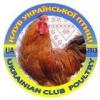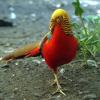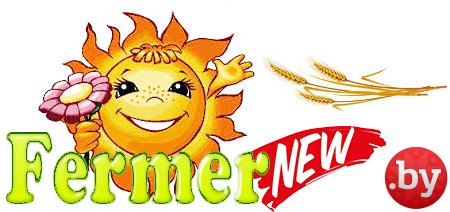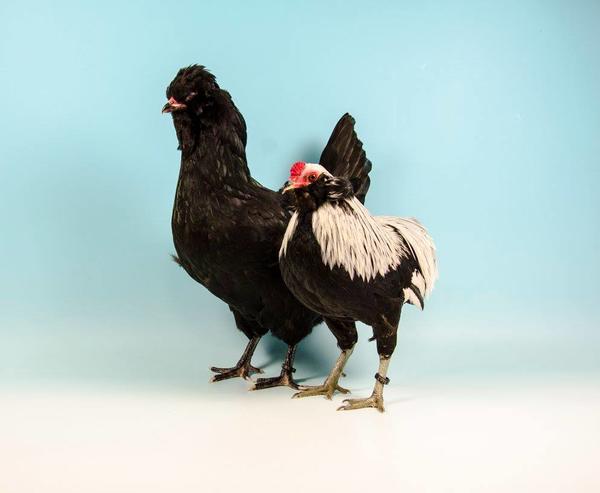
Араукана (с хвостом) / English Araucana
Автор
Mikhalych
, 07 окт 2017 09:49
куры породы кур араукана araucana
Сообщений в теме: 3
#1

Отправлено 07 Октябрь 2017 - 09:49
TAILED
LARGE FOWL
Origin: Chile
Classification: Light, Soft Feather
Egg Colour: Blue or green
When the Spaniards arrived in South America, bringing with them the light Mediterranean breeds, they found that the indigenous Indians had domestic fowl which soon cross-bred with the incomers. Notable for their fierce resistance to the Spaniards, however, were the Indians of the Arauca province of northern Chile who were never conquered. The name Araucana for the breed is derived therefore from that part of the world where the South American and European fowls had the least opportunity to interbreed.
The Araucana breed standard in the British Isles is generally as envisaged by George Malcolm who created the true-breeding lavender Araucana, among other colours, in Scotland during the 1930’s. Araucanas are prolific layers of strong-shelled eggs, blue or green eggs having been reported from South America from the mid-sixteenth century onwards. These are unique in that their colour permeates throughout the shell.
General Characteristics:
Male:
Carriage: Alert and active
Type: Body long and deep, free from heaviness. Firm in handling. Back moderately long, horizontal. Wings large and strong. Tail well developed with full sickles carried at an angle of 45 degrees.
Head: Moderately small. Beak strong and stout. Eyes bold. Comb small pea. Face covered with thick muffling and ear muffs abundant. Crest compact, carried well back from eyes. Ear-lobes moderately small and concealed by muffling. Wattles absent.
Neck: Of medium length, abundantly furnished with hackle feathers.
Legs and feet: Medium length, strong and well apart. Shanks free from feathers. Toes, four, straight and well spread.
Female:
The general characteristics are similar to those of the male, allowing for the natural sexual differences. Comb pea.
Colour
The Lavender
Male and female plumage: An even shade of blue-grey throughout.
The Blue
Male plumage: Breast, belly, thighs, tail and closed secondaries the colour of new slate. Hackle, saddle and shoulders and sometimes the tail coverts and the primaries, two shades darker (like a slate after being wetted). Fluff slate-blue.
Female plumage: Blue slate colour with dark hackle like the male, often marked or laced all over with the darker shade. Fluff slate-blue.
The Black-Red
Male plumage: Breast, thighs, belly, tail and wings black. Wing bars green-black: secondaries when closed bay. Crest, head and neck orange-red striped black. Back, shoulders and wing bow red or mahogany. Saddle hackle to match neck hackle. Fluff grey.
Female plumage: Hackle rich golden yellow broadly striped with black. Breast salmon. Muff salmon. Salmon and ash-grey on thighs. Body colour brown pencilled black, each feather with a pale shaft. Tail brown spotted or grizzled with black. Fluff grey.
The Silver Duckwing
Male plumage: Resembles the black-breasted red in the black markings and blue wing bars; rest of the plumage clear silvery white. Fluff light grey.
Female plumage: Hackle white, lightly striped black. Body and wings even silvery grey. Breast pale salmon. Primaries and tail nearly black. Fluff light grey.
The Golden Duckwing
Male plumage: Hackle and saddle yellow straw. Shoulders deep golden. Wing bars steel blue; secondaries yellow or creamy straw when closed, remaining plumage black. Fluff light grey.
Female plumage: Breast deeper, richer colour and body slightly browner tinge than the silver duckwing female. Fluff light grey.
The Blue-red
Male plumage: The same colour pattern as the black-red with slate replacing black. Breast, thighs, belly and tail slate. Secondaries when closed bay. Wing bar slate. Hackle and saddle feathers orange-red with blue centre stripe. Shoulders deep crimson-scarlet. Fluff dark slate.
Female plumage: Hackle golden striped. Breast and muff salmon. Body, wings and tail blue, finely peppered with golden brown. Fluff dark slate.
The Pile
Male plumage: The pile is marked exactly like the black-red except that the black is exchanged for a clear cream-white. Secondaries bay.
Female plumage: Creamy-white with salmon breast and golden striped hackle.
The Crele
Male and female plumage: Neck hackle straw barred with gold or black. Back and shoulder bright gold-chestnut barred with straw-yellow. Wing bar dark grey barred with pale grey; primaries and secondaries dark grey barred with pale; outer web of secondaries chestnut, the chestnut only showing when wing closed. Saddle hackle pale straw barred gold. Breast and underparts dark grey. Tail and tail coverts dark grey barred with light grey. Legs and feet white, with some spotting allowed.
The Spangled
Male and female plumage: These have white tips to their feathers. The more of these spots and the more regularly they are distributed the better. The male should show white ends to the feathers on hackle and saddle. The colour may be red, black or brown, or a mixture of all three. Fluff white.
The Cuckoo
Male and female plumage: Light grey-blue ground colour, each feather crossed with broad bands of dark blue-grey. In the male, a lighter shade is permissible. Undercolour banded but of a lighter shade. Beak light horn or bluish. Legs and feet white with blue spots.
The Black
Male and female plumage: Black with green sheen.
The White
Male and female plumage: Snow-white throughout.
In box sexes and all colours:
Comb and face bright red. Eyes dark orange. Beak and nails horn. Legs in all colours except cuckoo, willow to olive or slate.
Weights
Male2.70-3.20kg (6-7lb)
Female2.25-2.70kg (5-6lb)
Scale of Points
Type and carriage 20
Crest and muffling 25
Comb 10
Other head points 5
Feet and legs 5
Colour 20
Condition & handling 15
100
Serious defects or disqualifications
Cut-away breast. Roach back. Wry or squirrel tail. Crest too small or too large, e.g. Poland type. Absence of crest or muffling. Comb other than of pea type. Comb lopped or twisted. Any comb other than minimal in female. Pearl eye. Feathered legs. Legs other than standard colour. Uneven or splashed breast colour. In males white base in tail. In lavenders any straw or brassy tinge.
BANTAM
The standard to be an exact miniature of the large fowl.
Weights
Male740-850g (26-30oz)
Female680-790g (24-28oz)
Serious Defects
As large fowl, plus low wing carriage. High tail carriage. Any tendency to rose comb. Scale of points as in large fowl.
RUMPLESS ARAUCANA
LARGE FOWL
Origin: Chile
Classification: Light, Soft Feather
Egg Colour: Blue or green
The Rumpless Araucana also has its origins in South America. It was introduced to Europe by Professor S. Castello in the early 1920’s. The ear-tufts of feathers are unique to the breed in that they grow from a fleshy pad adjacent to the ear-lobe. Rumpless Araucanas lay a large egg in relation to body size and are as productive as the tailed Araucanas.
General Characteristics:
Male
Carriage: Alert, active and assured.
Type: Body moderate in length, broad at shoulders. Back flat and slightly sloped. Rump well rounded with saddle feathers flowing over stern. Breast full, round and deep. Wings medium in length, carried close to the body and well up. Saddle hackle well developed. Tail entirely absent, with no uropygium (parson’s nose).
Head: Moderately small. Beak medium stout, curved. Eyes bold and expressive. Comb small pea. Face moderate muffling. Ear-lobes small and concealed by ear-tufts. These originate from a gristly appendage arising from behind and just below the ear hole. The tufts of feathers, numbering from 5 to 15, grow from this pad. The tufts should be of a good length, matching in size and extending from the ears backwards in a well-defined sweep, or projecting horizontally. Wattles very small.
Neck: Medium length, well furnished with hackle feathers.
Legs and feet: Medium in length, straight and well set apart. Toes, four, strong and well spread.
Female
The general characteristics are similar to those of the male, allowing for the natural sexual differences.
Colour
Male and female plumage: As for Tailed Araucanas.
In both sexes and all colours
Eyes dark orange. Legs and feet willow to olive or slate.
Weights
Excess weight to be penalised.
Male2.70kg (6lb)
Female2.25kg (5lb)
Scale of points
Type and carriage 20
Ear-tufts 25
Comb 5
Other head points 5
Feet and legs 5
Colour 15
Condition & handling 25
100
Serious defects
Non-standard comb. Unmatched ear-tufts. Shape other than standard, e.g. narrow body. Any tail feathers (incomplete rumpless). Fluff showing below saddle hackle.
Disqualifications
No ear-tufts, single ear-tuft, crest. Uropygium (parson’s nose).
BANTAM
These should be a true miniature of the large Rumpless Araucana. As the large Rumpless fowl is historically and naturally a small breed, it follows that great care must be taken to keep the bantams within the approved weight limits. Colours at present include black-red, black and white.
Weights
Excess weight to be penalised.
Male910g (32oz)
Female790g (28oz)
Курицу хорошо есть вдвоём: я и курица.

#2

Отправлено 07 Октябрь 2017 - 09:52
 image_34.jpg 41,16К
0 Количество загрузок:
image_34.jpg 41,16К
0 Количество загрузок: image_35.jpg 46,94К
0 Количество загрузок:
image_35.jpg 46,94К
0 Количество загрузок: image_36.jpg 35,2К
0 Количество загрузок:
image_36.jpg 35,2К
0 Количество загрузок: image_37.jpg 38,63К
0 Количество загрузок:
image_37.jpg 38,63К
0 Количество загрузок: image_38.jpg 36,66К
0 Количество загрузок:
image_38.jpg 36,66К
0 Количество загрузок: image_39.jpg 62,71К
0 Количество загрузок:
image_39.jpg 62,71К
0 Количество загрузок: image_40.jpg 74,39К
0 Количество загрузок:
image_40.jpg 74,39К
0 Количество загрузок: image_41.jpg 66,92К
0 Количество загрузок:
image_41.jpg 66,92К
0 Количество загрузок:
Курицу хорошо есть вдвоём: я и курица.

#3

Отправлено 07 Октябрь 2017 - 09:54
History...
THE BREED
The Araucana was officially named in the 1930s. The origins of the British Araucana go back at least a hundred years and mentions of blue egg laying chickens appear in the 1700s. When the Spanish arrived in South America, bringing with them their poultry, they found that the Incas had their own ancient breeds which soon crossed with the imported stock. However in the High Andes there were many areas where the terrain made conquest impossible. Subsequently, the Arauca Indians of Old Northern Chile were never conquered so their poultry remained pure and led to the name Araucana.
Pockets of wild Araucana can still be seen in the Amazon Basin and in isolated areas in the high fincas of the Andes Range. The expansion of the old Colonial British Empire during the formation of the commonwealth led to the Araucana taking up residence in many countries around the world. Indeed, to this day, the British Tailed Araucana can be found in over 60 countries.
The precise historical moment of introduction to the British Isles is not known however it is reported that a Chilean nitrate ship floundered off the coast of Scotland in the 1930’s and the descendants of bearded, muffed, tailed Araucanas that were aboard were scattered among the Inner Hebrides. There has been a huge amount of cross breeding with more modern varieties in the twentieth century. George Malcom of East Lothian, Scotland created the modern standard that now exists, which maintains the unique blue egg along with the beard, muff and crest.
THE CLUB
On the 17th October 1972 a committee meeting of the Rare Breed Society was held during the Malpas Young Stock Show. Mr Sheppy, the R.B.S. Secretary reported to the committee saying that the newly formed British Araucana Club had more than sufficient members to warrant a separate breed club and with the persistence of Mrs Dorian Roxburgh, its acting Secretary, the Araucana Breed was allowed to go it alone, classes had been arranged at the Poultry Club Championship Show to be held in Nottingham on February 3rd the following year (1973) and A J Sheppy had been invited to judge. The Araucana was removed from the list as a rare breed.
With Araucanas entered at Nottingham and the help of older established breeders, including Mr Malcom and Mr Smith, a standard was drawn up for the British Araucana and it was published in the 1974 Poultry Club Year Book.
The British Araucana Club, though was not the first club in the British Isels to cater for the breeds interests. 1956 saw the formation of the Araucana Society of Great Britain - which was actually based in Scotland - for many years its Secretary was Mrs E Main and its Chariman was Captain Hay of Hayfield. 1985 saw its demise and in all those years it never created a breed standard and would have nothing to do with the newly formed club.
E W Smith was made President of The British Aracucana Club and remained there until his death at 89 following a road accident on 15th May 1994. Mr Smith, who was a noted ornamental pheasant and budgie breeder, first acquired a sitting of Araucana eggs in 1935 from a Mr George Beaver, a rag-rug maker from Huddersfield, who travelled the world selling his wares. The offspring of this hatch produced nearly all males which were black red in colour, willow legged with a pea type comb falling to one side. Desperate for more females, a Mr G Edwards came to the rescue, having also had eggs from Mr George Beaver. Goerge Malcolm also had stock from Mr Edwards when he produced the Lavender using the auto-sexing Cream (Crested) Legbar.
Dorian Roxburgh remained in power for ten years and in that time promoted the Araucana with informative news around the world. In her time as Secretary the Rumpless Araucana (Collonca de Aretes) appeared on the scene. Regarded as a freak by older British type breeders it was, and still is, the true typed Araucana with its distinctive ear tufts. It is the only type seen in Europe and its country of origin, Chile. Only when the breed moved into the Americas did all the variations take place. Jackie Williams became the next Secretary followed by her mother Rosemary. Between them they pushed the Araucana by creating classes at many shows for both Large fowl and Bantam and of course eggs. Kath Simpkin then became Secretary and continued to push the breed forward amassing a membership of 340 members in 2004.
The egg and its colour is the main reason the breed is still with us. There have been many problems and the egg colour is to blame. For a long time before and after a standard was produced the attitude of many was 'oh well it must be an Araucana because it lays a blue egg' with total disregard for type, colour etc. Moving forwards the club is dedicated to the preservation of the Araucana in its purest form with birds conforming to breed standards as set out in the British Poultry Standards.
_________________________________________________________________________________
ПОРОДА
Araucana был официально назван в 1930 году. Истоки британской Araucana вернуться по крайней мере, сто лет, и упоминания о синем яйцекладки кур появляются в 1700-х годах. Когда испанцы прибыли в Южную Америку, принося с собой свою домашнюю птицу, они обнаружили, что инки имели свои собственные древние породы, которые вскоре скрещивались с импортированной акций. Однако в высокогорных Андах существует много областей, где рельеф местности, сделанные завоевания невозможно. Впоследствии Arauca индейцы Старого Северного Чили никогда не были завоеваны, так что их мясо птицы оставались чистыми и привели к имени Araucana.
Очаги дикого Araucana все еще можно увидеть в бассейне Амазонки и в отдаленных районах в высоких в усадьбы Анд. Расширение старой колониальной Британской империи во время образования Содружества привело к Araucana поселившись во многих странах по всему миру. В самом деле, по сей день, британский Хвостатые Araucana можно найти в более чем 60 странах.
Точная исторический момент введения на Британские острова не известно, однако сообщается, что чилийская селитра судно барахтался у берегов Шотландии в 1930-х годах и потомки бородатый, заглушен, хвостатые Araucanas, которые были на борту были рассеяны среди Внутренней Гебриды , Там было огромное количество скрещивания с более современными сортами в ХХ веке. Джордж Малкольм Восточного Лотиан, Шотландия создали современный стандарт, который существует в настоящее время, которая поддерживает уникальный синий яйцо вместе с бородой, муфте и гребень.
КЛУБ
На 17 октября 1972 года состоялось заседание комитета редкой породы общества во время Малпас молодняк Show. Г-н Sheppy, БРС секретарь сообщил Комитету о том, что вновь сформированный британской Araucana клуб имел более чем достаточно членов, чтобы гарантировать отдельный клуб породы и с сохранением г-жи Дориана Роксбург, исполняющего обязанности секретаря, Araucana Порода отпущена его в одиночку, классы были организованы в Poultry Club Championship Show, которая пройдет в Ноттингеме 3 февраля в следующем году (1973) и AJ Sheppy были приглашены судьи. Araucana был удален из списка в качестве редкой породы.
С Araucanas вошел в Ноттингеме и помощи старых установленных селекционеров, в том числе г-н Малькома и г-н Смит, стандарт был разработан для британской Araucana и она была опубликована в 1974 Poultry Club Year Book.
Британский Araucana клуб, хотя и не был первым клубом в британских Isels для удовлетворения интересов пород. 1956 увидел формирование Araucana общества Великобритании - который был фактически основан в Шотландии - на протяжении многих лет ее секретарь была г-жа E Main и его Chariman был капитан Сено Hayfield. В 1985 году ее кончину и все эти годы он никогда не создал стандарт породы и не будет иметь ничего общего с новообразованной клуба.
EW Смит был сделан президентом Британского Aracucana клуба и оставался там до своей смерти в 89 после дорожно-транспортного происшествия 15 мая 1994 года г-н Смит, который был известным декоративные фазаны и волнистый попугайчик заводчик, впервые приобрел заседание Araucana яиц в 1935 году из Джордж некий господин Бивер, тряпка-ковер производитель от Хаддерсфилд, который путешествовал по всему миру, продавая свои товары. Потомство этого люка производится почти всех мужчин, которые были черного красного цвета, ива ноги с типом гороховый гребень падает в одну сторону. Отчаявшись для большего количества женщин, некий господин G Эдвардс пришел на помощь, имея также были яйца от господина Джорджа Бивер. Goerge Malcolm также имел запас от г-Эдвардс, когда он произвел лаванды с помощью авто-Sexing крем (хохлатая) Legbar.
Дориан Роксбург оставался у власти в течение десяти лет и за это время способствовало Araucana с информативной новостей по всему миру. В свое время в качестве секретаря Rumpless Araucana (Collonca де Aretes) появился на сцене. Рассматриваемая как урод старыми заводчиками Британский типа это было, и до сих пор является истинным типизированных Araucana с его отличительные пучках уха. Это единственный тип видел в Европе и стране происхождения, Чили. Только тогда, когда порода переехала в Северной и Южной Америке сделали все вариации происходят. Джеки Уильямс стал очередным секретарем с последующим ее матерью Розмари. Между ними они подтолкнули Araucana путем создания классов на многих выставках как для крупных птиц и Bantam и конечно яйца. Kath Симпкин затем стал секретарем и продолжал толкать вперед породе накапливая членство 340 членов в 2004 году.
Яйцо и его цвет является основной причиной, порода все еще с нами. Там было много проблем, и цвет яйца виноват. В течение долгого времени до и после стандарта было произведено отношение многих было "ой хорошо это должен быть Araucana, потому что он закладывает синее яйцо" с полным пренебрежением к типу, цвету и т.д. Перемещение вперед клуб посвящен сохранению Araucana в его самой чистой форме с птицами, соответствующих стандартам породы, изложенные в британских стандартах птица.
Курицу хорошо есть вдвоём: я и курица.

Темы с аналогичным тегами куры, породы кур, араукана, araucana
Рынок →
Биржа птицевода →
Павловская Золотистая порода курАвтор Vladislav , 25 апр 2020 |
|

|
||
Форум Птицеводство →
Технические вопросы →
Дайте совет РебятаАвтор Петр_Иванович , 23 май 2018 |
|

|
||
Форум Птицеводство →
Общий о птице →
породы кур →
Карликовая дрезденская порода кур, Dresden bantam chickensАвтор Mikhalych , 05 янв 2018 |
|

|
||
Форум Птицеводство →
Общий о птице →
История птицеводства - книги, статьи, фото и т.п.Автор Mikhalych , 11 дек 2017 |
|

|
||
Рынок →
Биржа птицевода →
Царская птичка :)Автор Kationa82 , 12 ноя 2017 |
|

|
Количество пользователей, читающих эту тему: 1
0 пользователей, 1 гостей, 0 анонимных


 Форум
Форум














 Изменить стиль
Изменить стиль Помощь
Помощь